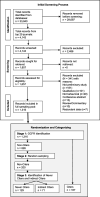Use of guidelines, checklists, frameworks, and recommendations in behavioral intervention preliminary studies and associations with reporting comprehensiveness: a scoping bibliometric review
- PMID: 37705118
- PMCID: PMC10498529
- DOI: 10.1186/s40814-023-01389-w
Use of guidelines, checklists, frameworks, and recommendations in behavioral intervention preliminary studies and associations with reporting comprehensiveness: a scoping bibliometric review
Abstract
Background: Guidelines, checklists, frameworks, and recommendations (GCFRs) related to preliminary studies serve as essential resources to assist behavioral intervention researchers in reporting findings from preliminary studies, but their impact on preliminary study reporting comprehensiveness is unknown. The purpose of this study was to conduct a scoping bibliometric review of recently published preliminary behavioral-focused intervention studies to (1) examine the prevalence of GCFR usage and (2) determine the associations between GCFR usage and reporting feasibility-related characteristics.
Methods: A systematic search was conducted for preliminary studies of behavioral-focused interventions published between 2018 and 2020. Studies were limited to the top 25 journals publishing behavioral-focused interventions, text mined to identify usage of GCFRs, and categorized as either not citing GCFRs or citing ≥ 2 GCFRs (Citers). A random sample of non-Citers was text mined to identify studies which cited other preliminary studies that cited GCFRs (Indirect Citers) and those that did not (Never Citers). The presence/absence of feasibility-related characteristics was compared between Citers, Indirect Citers, and Never Citers via univariate logistic regression.
Results: Studies (n = 4143) were identified, and 1316 were text mined to identify GCFR usage (n = 167 Citers). A random sample of 200 studies not citing a GCFR were selected and categorized into Indirect Citers (n = 71) and Never Citers (n = 129). Compared to Never Citers, Citers had higher odds of reporting retention, acceptability, adverse events, compliance, cost, data collection feasibility, and treatment fidelity (ORrange = 2.62-14.15, p < 0.005). Citers also had higher odds of mentioning feasibility in purpose statements, providing progression criteria, framing feasibility as the primary outcome, and mentioning feasibility in conclusions (ORrange = 6.31-17.04, p < 0.005) and lower odds of mentioning efficacy in purpose statements, testing for efficacy, mentioning efficacy in conclusions, and suggesting future testing (ORrange = 0.13-0.54, p < 0.05). Indirect Citers had higher odds of reporting acceptability and treatment fidelity (ORrange = 2.12-2.39, p < 0.05) but lower odds of testing for efficacy (OR = 0.36, p < 0.05) compared to Never Citers.
Conclusion: The citation of GCFRs is associated with greater reporting of feasibility-related characteristics in preliminary studies of behavioral-focused interventions. Researchers are encouraged to use and cite literature that provides guidance on design, implementation, analysis, and reporting to improve the comprehensiveness of reporting for preliminary studies.
Keywords: Feasibility; Framework; Pilot; Preliminary studies; Reporting quality; Review.
© 2023. BioMed Central Ltd., part of Springer Nature.
Conflict of interest statement
The authors declare that they have no competing interests.
Figures
Similar articles
-
Expert Perspectives on Pilot and Feasibility Studies: A Delphi Study and Consolidation of Considerations for Behavioral Interventions.Res Sq [Preprint]. 2023 Dec 15:rs.3.rs-3370077. doi: 10.21203/rs.3.rs-3370077/v1. Res Sq. 2023. Update in: Pilot Feasibility Stud. 2024 Apr 6;10(1):57. doi: 10.1186/s40814-024-01485-5. PMID: 38168263 Free PMC article. Updated. Preprint.
-
Consolidated guidance for behavioral intervention pilot and feasibility studies.Pilot Feasibility Stud. 2024 Apr 6;10(1):57. doi: 10.1186/s40814-024-01485-5. Pilot Feasibility Stud. 2024. PMID: 38582840 Free PMC article.
-
Feasibility indicators in obesity-related behavioral intervention preliminary studies: a historical scoping review.Pilot Feasibility Stud. 2023 Mar 22;9(1):46. doi: 10.1186/s40814-023-01270-w. Pilot Feasibility Stud. 2023. PMID: 36949541 Free PMC article.
-
The future of Cochrane Neonatal.Early Hum Dev. 2020 Nov;150:105191. doi: 10.1016/j.earlhumdev.2020.105191. Epub 2020 Sep 12. Early Hum Dev. 2020. PMID: 33036834
-
The mysterious case of the disappearing pilot study: a review of publication bias in preliminary behavioral interventions presented at health behavior conferences.Pilot Feasibility Stud. 2023 Jul 7;9(1):115. doi: 10.1186/s40814-023-01345-8. Pilot Feasibility Stud. 2023. PMID: 37420279 Free PMC article. Review.
Cited by
-
Balancing best practice and reality in behavioral intervention development: A survey of principal investigators funded by the National Institutes of Health.Transl Behav Med. 2024 Apr 29;14(5):273-284. doi: 10.1093/tbm/ibae009. Transl Behav Med. 2024. PMID: 38493078 Free PMC article.
-
Expert Perspectives on Pilot and Feasibility Studies: A Delphi Study and Consolidation of Considerations for Behavioral Interventions.Res Sq [Preprint]. 2023 Dec 15:rs.3.rs-3370077. doi: 10.21203/rs.3.rs-3370077/v1. Res Sq. 2023. Update in: Pilot Feasibility Stud. 2024 Apr 6;10(1):57. doi: 10.1186/s40814-024-01485-5. PMID: 38168263 Free PMC article. Updated. Preprint.
-
Development of a nurse-led, evidence-based, and theory-informed dietary intervention to modify multiple unhealthy dietary behaviors in gastric cancer survivors.Asia Pac J Oncol Nurs. 2025 Jun 9;12:100739. doi: 10.1016/j.apjon.2025.100739. eCollection 2025 Dec. Asia Pac J Oncol Nurs. 2025. PMID: 40611825 Free PMC article.
-
Are the Risk of Generalizability Biases Generalizable? A Meta-Epidemiological Study.Res Sq [Preprint]. 2024 Feb 26:rs.3.rs-3897976. doi: 10.21203/rs.3.rs-3897976/v1. Res Sq. 2024. PMID: 38464006 Free PMC article. Preprint.
-
Consolidated guidance for behavioral intervention pilot and feasibility studies.Pilot Feasibility Stud. 2024 Apr 6;10(1):57. doi: 10.1186/s40814-024-01485-5. Pilot Feasibility Stud. 2024. PMID: 38582840 Free PMC article.
References
-
- Hoffmann TC, Glasziou PP, Boutron I, Milne R, Perera R, Moher D, et al. Better reporting of interventions: Template for Intervention Description and Replication (TIDieR) checklist and guide. Bmj-Brit Med J. 2014;348:1–12 - PubMed
Publication types
Grants and funding
LinkOut - more resources
Full Text Sources


